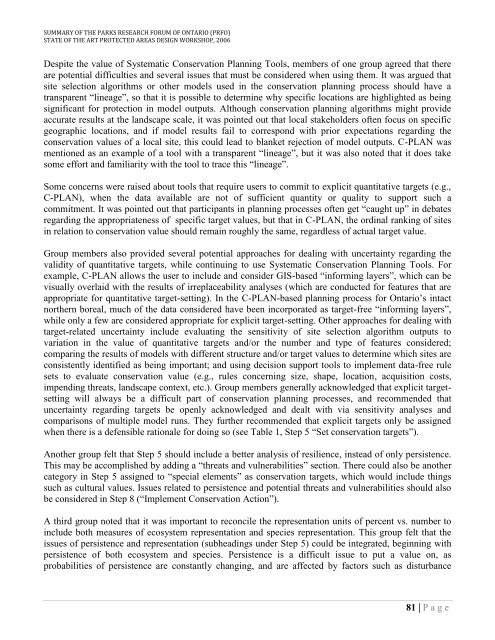Top-Down vs. Bottom Up: Working Towards Consensus ... - CASIOPA
Top-Down vs. Bottom Up: Working Towards Consensus ... - CASIOPA
Top-Down vs. Bottom Up: Working Towards Consensus ... - CASIOPA
- No tags were found...
You also want an ePaper? Increase the reach of your titles
YUMPU automatically turns print PDFs into web optimized ePapers that Google loves.
SUMMARY OF THE PARKS RESEARCH FORUM OF ONTARIO (PRFO)STATE OF THE ART PROTECTED AREAS DESIGN WORKSHOP, 2006Despite the value of Systematic Conservation Planning Tools, members of one group agreed that thereare potential difficulties and several issues that must be considered when using them. It was argued thatsite selection algorithms or other models used in the conservation planning process should have atransparent “lineage”, so that it is possible to determine why specific locations are highlighted as beingsignificant for protection in model outputs. Although conservation planning algorithms might provideaccurate results at the landscape scale, it was pointed out that local stakeholders often focus on specificgeographic locations, and if model results fail to correspond with prior expectations regarding theconservation values of a local site, this could lead to blanket rejection of model outputs. C-PLAN wasmentioned as an example of a tool with a transparent “lineage”, but it was also noted that it does takesome effort and familiarity with the tool to trace this “lineage”.Some concerns were raised about tools that require users to commit to explicit quantitative targets (e.g.,C-PLAN), when the data available are not of sufficient quantity or quality to support such acommitment. It was pointed out that participants in planning processes often get “caught up” in debatesregarding the appropriateness of specific target values, but that in C-PLAN, the ordinal ranking of sitesin relation to conservation value should remain roughly the same, regardless of actual target value.Group members also provided several potential approaches for dealing with uncertainty regarding thevalidity of quantitative targets, while continuing to use Systematic Conservation Planning Tools. Forexample, C-PLAN allows the user to include and consider GIS-based “informing layers”, which can bevisually overlaid with the results of irreplaceability analyses (which are conducted for features that areappropriate for quantitative target-setting). In the C-PLAN-based planning process for Ontario‟s intactnorthern boreal, much of the data considered have been incorporated as target-free “informing layers”,while only a few are considered appropriate for explicit target-setting. Other approaches for dealing withtarget-related uncertainty include evaluating the sensitivity of site selection algorithm outputs tovariation in the value of quantitative targets and/or the number and type of features considered;comparing the results of models with different structure and/or target values to determine which sites areconsistently identified as being important; and using decision support tools to implement data-free rulesets to evaluate conservation value (e.g., rules concerning size, shape, location, acquisition costs,impending threats, landscape context, etc.). Group members generally acknowledged that explicit targetsettingwill always be a difficult part of conservation planning processes, and recommended thatuncertainty regarding targets be openly acknowledged and dealt with via sensitivity analyses andcomparisons of multiple model runs. They further recommended that explicit targets only be assignedwhen there is a defensible rationale for doing so (see Table 1, Step 5 “Set conservation targets”).Another group felt that Step 5 should include a better analysis of resilience, instead of only persistence.This may be accomplished by adding a “threats and vulnerabilities” section. There could also be anothercategory in Step 5 assigned to “special elements” as conservation targets, which would include thingssuch as cultural values. Issues related to persistence and potential threats and vulnerabilities should alsobe considered in Step 8 (“Implement Conservation Action”).A third group noted that it was important to reconcile the representation units of percent <strong>vs</strong>. number toinclude both measures of ecosystem representation and species representation. This group felt that theissues of persistence and representation (subheadings under Step 5) could be integrated, beginning withpersistence of both ecosystem and species. Persistence is a difficult issue to put a value on, asprobabilities of persistence are constantly changing, and are affected by factors such as disturbance81 | P a g e


